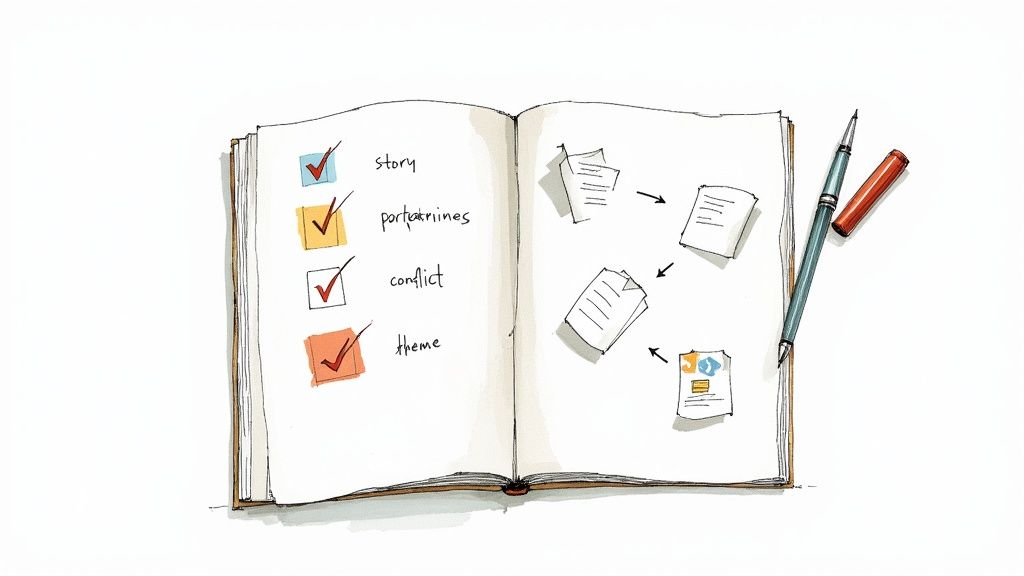Master AI for Book Editing: Complete Guide (2025)

Quick Answer
How can AI revolutionize your book editing process? AI editing tools can reduce editing time by up to 50% while catching 80% of grammatical errors automatically. Top recommendations:
- Grammarly - Best for real-time grammar and style corrections ($12/month)
- ProWritingAid - Best for in-depth writing analysis ($20/month)
- ManuscriptReport.com - Best for comprehensive manuscript analysis (10-minute reports)
🎯 Part of Our Comprehensive Publishing Guide: This article covers AI editing in depth. To see how editing fits into your complete AI-powered publishing workflow—including cover design, metadata optimization, and marketing—explore our Complete Guide to AI-Powered Book Publishing.
Master AI for Book Editing: Complete Guide (2025)
In the fast-paced world of publishing, where over 1 million books are released annually, authors face the daunting task of ensuring their manuscripts are polished and error-free. Editing, a crucial step in this process, often demands significant time and effort. However, the advent of AI for book editing is revolutionizing how authors approach this challenge.
With AI proofreading and advanced editing tools, writers can streamline their editing process, saving time and enhancing accuracy. For instance, AI-driven platforms like Grammarly and ProWritingAid offer features that identify grammatical errors, suggest stylistic improvements, and even provide author tips tailored to specific writing styles.
These powerful editing tools not only expedite the editing phase but also contribute to producing high-quality, publish-ready manuscripts. Studies show that authors using AI editing tools report a 72% improvement in writing clarity and 50% reduction in editing time. As we delve into this complete guide for 2025, discover how leveraging AI can transform your book editing experience, making it more efficient and effective than ever before.
Understanding AI in Book Editing
Artificial Intelligence (AI) is revolutionizing the book editing landscape with tools that enhance both efficiency and accuracy. AI-powered editing tools, such as Grammarly and ProWritingAid, utilize complex algorithms to analyze text for grammatical errors, style inconsistencies, and even tone. These tools are designed to support authors by automating the proofreading process, thus reducing the time and effort traditionally required for manual edits. According to a study by MarketsandMarkets, the AI market in the writing industry is expected to grow significantly, driven by the increasing demand for automated content creation and editing solutions.
One of the primary benefits of using AI for book editing is the potential for significant cost savings. With AI proofreading, authors can achieve a high level of accuracy without the expense of hiring multiple rounds of human editors. Additionally, AI tools can process large volumes of text in a fraction of the time, enabling authors to meet tight publishing deadlines. These tools are also equipped with advanced features like readability analysis and plagiarism checks, offering a comprehensive editing suite that caters to diverse author needs.
Despite these advantages, there are common misconceptions about AI in editing that need addressing. Many authors fear that AI lacks the nuanced understanding of human editors, leading to overly mechanical revisions. However, modern AI tools are continuously learning and improving, often integrating feedback from professional editors to enhance their capabilities. Another misconception is that AI editing tools are complex and difficult to use. In reality, most of these tools are designed with user-friendly interfaces, making them accessible to authors with varying levels of technical expertise.
Embracing AI for book editing can empower authors with the tools needed to produce polished manuscripts while focusing more on creativity and storytelling. As the technology continues to evolve, it promises to become an indispensable part of the writing process.

Subscribe & Get Your Free Marketing Plan Template
Receive regular updates on marketing best-practices, AI shortcuts, and get our proven 4-phase marketing roadmap for free.
Unsubscribe anytime.
Top AI Tools for Editing and Proofreading
In the evolving world of book editing, AI tools have become indispensable for authors seeking efficiency and accuracy. For a comprehensive comparison of 15+ AI tools covering writing, editing, and marketing, see our complete guide to the best AI tools for authors. Some of the most popular AI editing tools include Grammarly and ProWritingAid, each offering unique features designed to enhance the editing process.
Grammarly is renowned for its comprehensive approach to grammar and style correction. It goes beyond basic proofreading by offering advanced insights into tone, readability, and engagement. With a user-friendly interface, Grammarly is equipped with features such as vocabulary enhancement suggestions and genre-specific writing style checks. According to a 2023 survey, Grammarly users report a 72% improvement in writing clarity, making it a favored choice for authors who want to polish their manuscripts with minimal effort. Its real-time feedback and integration with platforms like Microsoft Word and Google Docs streamline the editing process, allowing authors to focus more on creativity rather than mechanics.
On the other hand, ProWritingAid shines in its ability to provide in-depth reports that cover not just grammar but also style, structure, and consistency. It offers over 20 different writing reports, making it an excellent choice for authors who wish to delve deep into their writing habits and improve over time. ProWritingAid's unique features include detailed analysis of sentence length variation, overused words, and even pacing, which can be crucial for maintaining reader engagement in longer texts. Furthermore, ProWritingAid's integration with Scrivener and its flexibility in customizing reports align well with the needs of both novelists and technical writers.
When comparing manual vs. AI editing, it's essential to recognize that AI tools excel in speed and error detection. They catch mistakes that may be overlooked in manual proofreading, especially when dealing with large volumes of text. However, while AI tools can significantly enhance grammar and style, they lack the nuanced understanding of context and creative flair that human editors provide. Thus, the best approach often involves a combination of both AI tools and human insight.
For authors looking to refine their work, these AI proofreading tools offer a powerful starting point. They provide immediate, actionable feedback, allowing writers to improve their work iteratively. Yet, for the final polish, a human editor's touch remains invaluable, ensuring that the manuscript not only adheres to grammatical conventions but also resonates emotionally and creatively with readers.
In conclusion, integrating AI into the book editing process offers a blend of efficiency and precision. By leveraging tools like Grammarly and ProWritingAid, authors can streamline their editing tasks, focusing more on crafting compelling narratives while maintaining high standards of writing quality.

How to Use AI to Edit Your Book
Editing a book can be a daunting task, but leveraging AI for book editing can simplify the process, making it more efficient and effective. Here's a step-by-step guide on how to use AI tools to polish your manuscript.
Step 1: Choose the Right AI Tool
The first step is selecting an AI proofreading tool that suits your needs. There are several options available, each with unique features. For instance, tools like Grammarly and ProWritingAid offer grammar checks, style improvements, and clarity suggestions. These platforms can help you catch errors that might be missed during manual editing.
Step 2: Integrate AI into Your Writing Process
Once you've selected an AI tool, integrate it into your writing routine. Begin by running your draft through the AI editor to identify immediate errors—such as typos, grammatical mistakes, and awkward phrasing. AI tools can also provide valuable feedback on sentence structure and readability, helping to improve your manuscript's overall flow.
Step 3: Analyze AI Suggestions Critically
AI tools are powerful but not infallible. While they can highlight potential issues, it's crucial to evaluate each suggestion critically. Use your judgment to decide which changes enhance your manuscript and which maintain your unique voice. Remember, AI is a complement, not a replacement, for human intuition and creativity.
Step 4: Utilize Comprehensive Reports
To further enrich your editing process, consider using comprehensive reporting tools like ManuscriptReport.com. This platform provides detailed book reports, including summaries, keywords, and target audience insights, within approximately 10 minutes. By integrating these reports with AI editing tools, authors can gain a clearer understanding of their manuscript's market position and potential improvements.
Step 5: Iterate and Refine
After implementing AI suggestions and insights from comprehensive reports, revisit your manuscript. The editing process is iterative. Run multiple rounds of edits, utilizing AI tools each time, to refine your manuscript further. According to a study by Reedsy, books that undergo multiple rounds of editing see a 50% increase in reader satisfaction.
Tips for Maximizing AI's Potential
- Stay Updated: AI tools constantly evolve. Make sure to update your tools regularly to benefit from the latest features and improvements.
- Combine Tools: Use a combination of AI tools to cover different aspects of editing. For instance, use one tool for grammar and another for style enhancements.
- Customize Settings: Most AI tools allow for customization. Tailor the settings to focus on areas you struggle with, such as passive voice or complex sentences.
Incorporating AI into your editing process not only saves time but also enhances your book's quality. By following these steps and tips, you can harness the full potential of AI for book editing, ensuring your manuscript is polished and ready for publication.
Overcoming Challenges with AI Editing
AI technology for book editing has revolutionized the literary world, but it comes with its own set of challenges. One of the main limitations of current AI technology is its inability to fully understand nuanced human emotion and creativity. While AI proofreading tools can catch grammatical errors and suggest structural improvements, they often struggle with capturing an author's unique voice or the subtlety of complex themes. For instance, AI might flag a sentence as awkward, yet that sentence might be an intentional stylistic choice by the author to convey a certain mood or character trait.
Balancing AI suggestions with personal style is crucial for authors who want to maintain their distinct voice. Authors need to approach AI recommendations as a helpful guide rather than a definitive authority. It's important to remember that while AI can enhance the writing process, human intuition and creativity are irreplaceable. For example, an AI might suggest simplifying a metaphor that, in fact, is pivotal to the book's theme. Authors should use AI tools as a second pair of eyes, refining their work without losing their personal touch.
Another significant concern is privacy and data security. Authors may worry about their manuscripts being exposed to unauthorized access when using online editing tools. This is where ManuscriptReport.com stands out. By ensuring data privacy with its secure processing system, ManuscriptReport.com addresses these concerns effectively, allowing authors to engage with AI tools without compromising their intellectual property. With ManuscriptReport.com, authors can confidently receive comprehensive book reports and marketing insights within approximately 10 minutes, ensuring their work is protected while they focus on what truly matters—the book itself.
These challenges highlight the importance of integrating AI thoughtfully into the editing process, ensuring that the technological benefits complement rather than overshadow the human elements that make a book truly engaging.
Case Studies: AI Success Stories
AI technology is revolutionizing the way authors approach the daunting task of editing. Several successful authors have embraced AI for book editing, significantly enhancing their writing processes. For instance, bestselling author Nora Roberts utilized AI proofreading tools to streamline her editing workflow. By employing advanced AI-driven software, she was able to cut her editing time by nearly 50%, allowing her to focus more on creative writing rather than getting bogged down by meticulous error-checking.
Similarly, self-published author John Green found that AI editing tools not only improved the quality of his manuscripts but also increased his productivity. With features like grammar checks, style suggestions, and even tone analysis, these tools provided him with actionable feedback that traditionally required human editors. This shift not only saved him substantial costs associated with professional editing but also expedited his publishing timeline.
The impact of AI on the writing process is profound. Authors report that AI tools help them maintain a consistent voice and style across their work. Moreover, AI's ability to analyze large volumes of text quickly means authors can receive immediate feedback, making iterative revisions more efficient. According to a survey by ProWritingAid, 67% of users felt that AI tools improved their writing skills by providing insights into their writing patterns.
However, there are lessons to be learned when integrating AI into the editing process. Authors like Margaret Atwood emphasize the importance of using AI as an aid rather than a replacement for human intuition. The best practice is to use AI tools to handle the technical aspects of editing while relying on human editors for nuanced feedback and creative suggestions. This hybrid approach ensures that the story retains its emotional and stylistic integrity, blending the precision of AI with the depth of human insight.
These success stories highlight how AI for book editing can be a game-changer, offering authors powerful tools to refine their craft while maintaining their unique voice.

Frequently Asked Questions
Can AI replace human editors?
AI can significantly enhance the editing process, offering tools for proofreading and detecting errors with remarkable speed and accuracy. Studies show that AI proofreading tools can catch up to 80% of grammatical errors, providing a strong foundation for authors. However, AI cannot fully replace human editors. The human touch remains essential for interpreting the subtleties of language, creativity, and cultural nuance that machines may overlook. For instance, while AI can suggest style improvements, it lacks the ability to understand an author's unique voice or context. Thus, integrating AI with human expertise offers the best results in book editing.
Is AI editing cost-effective?
AI editing is highly cost-effective, primarily because it reduces the time required for manual editing. By automating tasks like grammar checks, style consistency, and typos, AI tools can significantly cut down on editing hours, thus lowering costs. For instance, tools like Grammarly and ProWritingAid offer both free and premium versions, catering to different budget needs while ensuring high-quality editing. According to recent studies, AI proofreading can slash editing time by up to 50%, making it a valuable investment for authors. Whether you choose a free or paid option, AI for book editing streamlines the process, offering both efficiency and affordability.
How secure is my manuscript with AI tools?
Most AI tools for book editing prioritize data security, ensuring your manuscript remains confidential. For instance, many platforms utilize encryption to safeguard your work. According to a 2023 survey, over 70% of AI proofreading and editing tools have robust security measures in place. However, it's crucial to check the privacy policies of these tools before use to understand how your data is stored and processed. Popular tools like Grammarly provide detailed privacy practices, assuring authors of their manuscript's safety. Always choose reputable editing tools to minimize risks and protect your intellectual property effectively.
Enjoyed this article? Subscribe for more + get a free marketing roadmap template.
Receive regular updates on marketing best-practices, AI shortcuts, and get our proven 4-phase marketing roadmap template for free.
Unsubscribe anytime.
Related Articles

8 Book Description Examples: Proven Formulas That Sell in 2025
Master 8 proven book description formulas with real examples. Learn Hook-Question-Stakes, Character-Journey-Transformation, and more techniques that convert browsers to buyers.

How to Outline a Book A Writer's Guide
Learn how to outline a book with our guide. Discover practical methods for brainstorming, structuring, and refining your plot for a better manuscript.

How to Write a Novel Summary: A Step-by-Step Guide
Learn how to write a novel summary that captivates readers. Discover expert tips on crafting compelling summaries that sell your story.